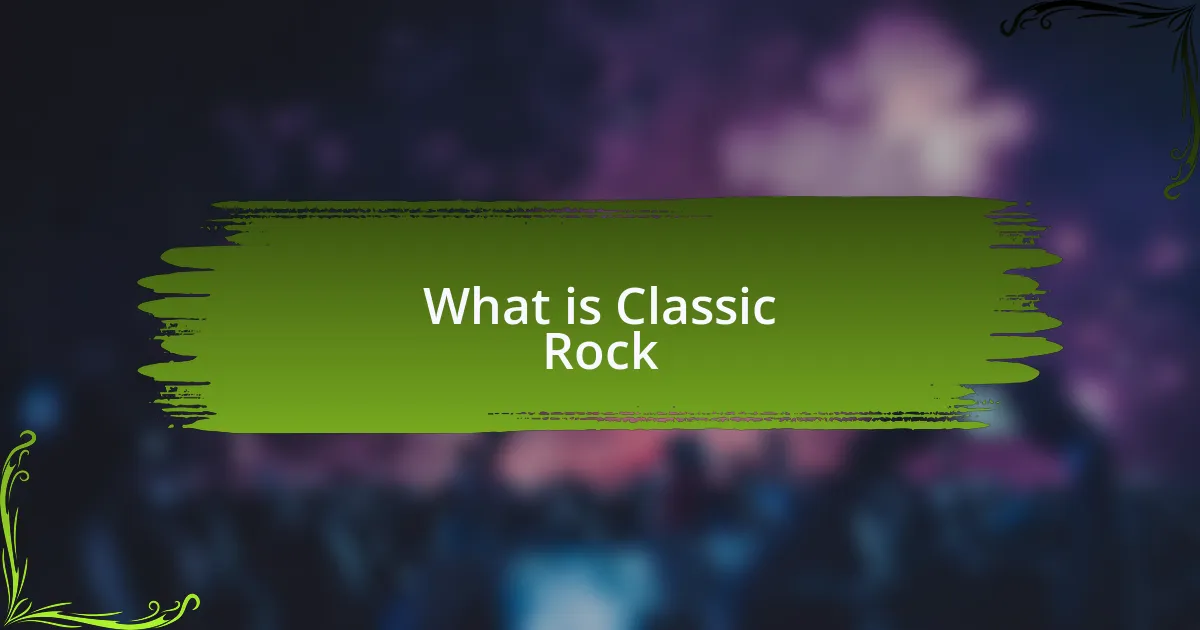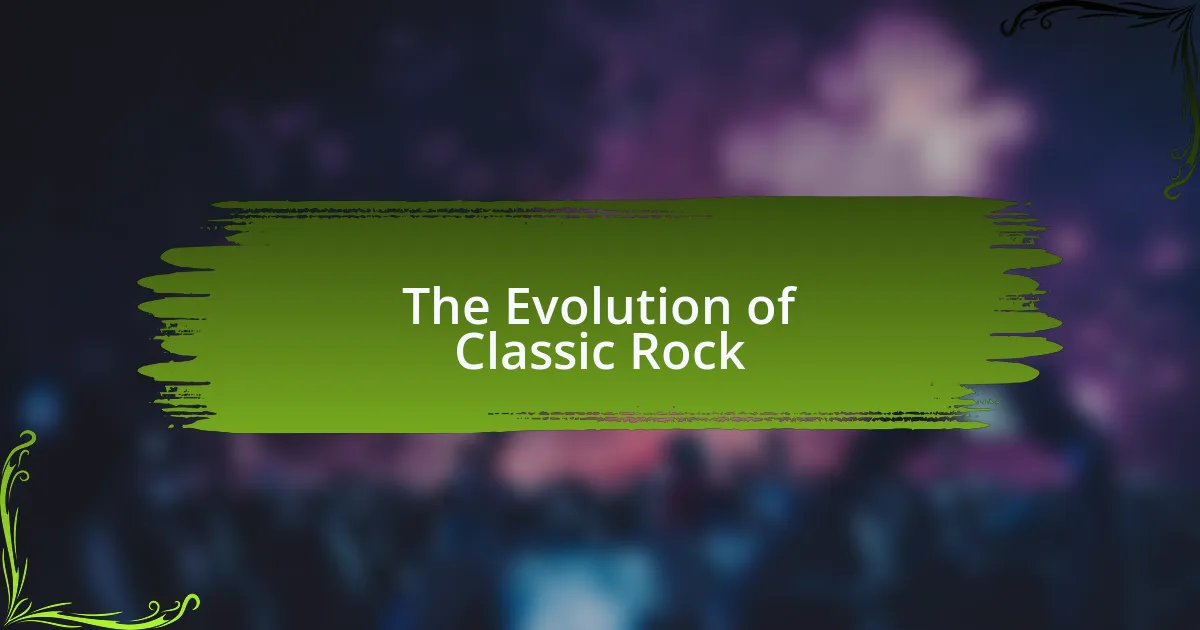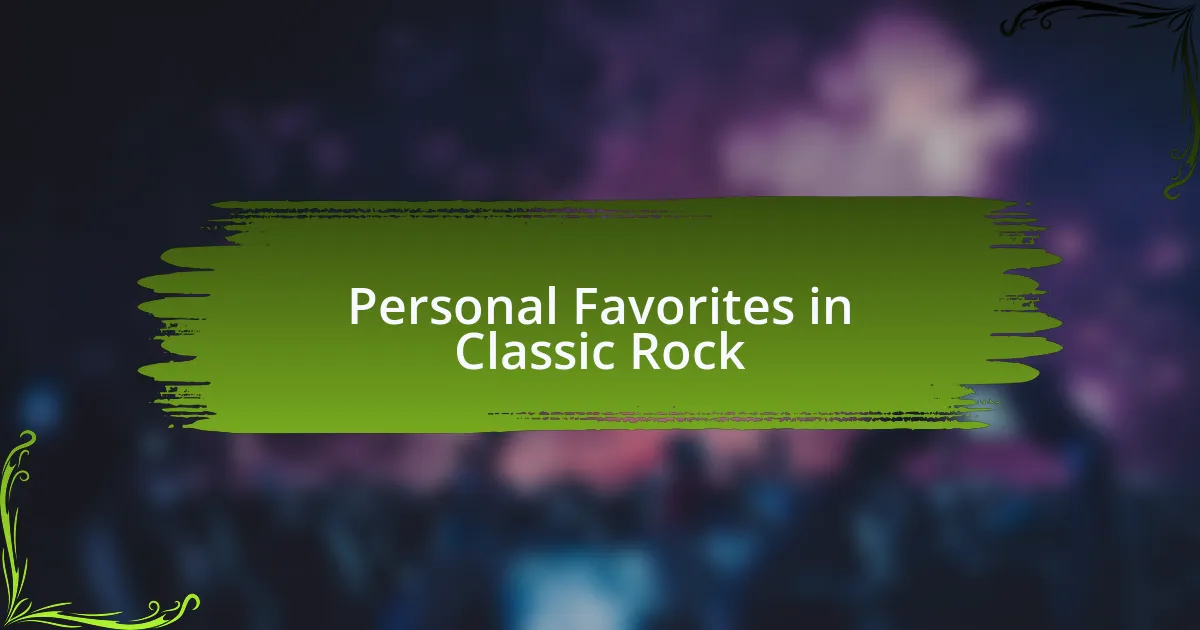Key takeaways:
- Classic rock emerged from the late 1960s to the late 1980s, characterized by powerful guitar riffs and emotional themes, shaping cultural identity and expression.
- The genre evolved from singles to album-oriented rock in the 1970s, fostering intricate compositions and storytelling, while the 1980s introduced influences from punk and new wave.
- Key artists such as Jimi Hendrix, Led Zeppelin, and Fleetwood Mac redefined classic rock through innovative techniques, compelling songwriting, and emotional resonance.
- Classic rock songs often create lasting memories, connecting listeners through personal experiences and shared emotions, reinforcing music’s power to guide and inspire.

What is Classic Rock
Classic rock is often defined as the rock music from the late 1960s to the late 1980s. It is characterized by powerful guitar riffs, memorable melodies, and anthemic choruses that resonate across generations. Think about the first time you heard a band like Led Zeppelin or Fleetwood Mac; doesn’t it feel like discovering a hidden treasure?
When I dive into classic rock, I’m transported back to my teenage years. I remember cranking up the volume on my dad’s vintage turntable, feeling every note of “Hotel California.” It’s more than just music; it’s an emotional journey that captures the spirit of freedom and rebellion, and it begs the question: how many of us have felt that same thrill in our lives?
The genre has been a cultural touchstone, influencing fashion, lifestyles, and even social movements. Bands like The Rolling Stones and The Who didn’t just create music; they became voices of a generation, shaping how we perceive identity and expression. Can you recall a moment when a classic rock song perfectly captured how you felt, making it seem like the universe was speaking directly to you?

The Evolution of Classic Rock
As classic rock began to surface in the late 1960s, it not only brought together diverse musical influences but also served as a platform for innovation. Artists were experimenting with new sounds, creating intricate compositions that pushed boundaries. I remember my first listen to a long, sprawling track; the way it transported me through different musical landscapes made me realize that classic rock was about exploration, not just repetition.
The 1970s marked a significant shift, as album-oriented rock took the forefront, changing how listeners experienced music. Gone were the days of singles dominating the airwaves; instead, I found myself captivated by entire albums that told a story from start to finish. This shift made me appreciate the artistry involved—each song crafted to lead me on a journey, leaving me eager to press repeat after the final note faded away.
By the time the 1980s rolled around, classic rock began to incorporate elements from emerging genres like punk and new wave. This fusion resulted in a vibrant sound that still celebrated the roots of rock while embracing modernity. I often wonder, how does this evolution resonate with us today? The music might have changed, but that same raw energy continues to pulse through the veins of today’s artists, bridging the past with the present in a remarkable way.

Key Characteristics of Classic Rock
Classic rock is defined by its powerful instrumentation and memorable melodies. The electric guitar often takes center stage, delivering iconic riffs that are instantly recognizable. I still recall the first time I heard those opening notes of “Smoke on the Water.” It was like a lightning bolt, charging me with an energy that made me want to turn up the volume and share that moment with friends.
Another hallmark of classic rock is its lyrical depth, often exploring themes of love, rebellion, and freedom. These songs resonate with listeners on a personal level, creating connections that can last a lifetime. I once sang along to a heart-wrenching ballad in my car, feeling every emotion as if the singer were telling my own story. That vulnerability in the lyrics made me appreciate how music can turn feelings into shared experiences, forging bonds with others who relate.
The fusion of different musical styles within classic rock is also noteworthy, blending blues, folk, and even jazz elements into its fabric. This rich tapestry creates a soundscape that brings dynamism to the genre. Whenever I hear a classic rock song that unexpectedly changes tempo or introduces a new instrument midway through, I can’t help but smile. It reminds me that discovery is at the heart of music, inviting listeners to explore new layers with each play.

Influential Classic Rock Artists
There are a few artists in classic rock who truly redefined the genre and left an indelible mark on music history. Take Jimi Hendrix, for instance. His innovative guitar techniques and explosive stage presence transformed rock performance. I remember watching a live concert recording of him at Woodstock, and it was difficult not to feel electrified by his energy and passion—it felt like he was creating a whole new language with his guitar.
Then there’s Led Zeppelin, a band known for their powerful anthems and theatrical performances. Their approach to songwriting, combining folk influences with hard rock, was groundbreaking. Hearing “Stairway to Heaven” for the first time felt like an awakening; each note seemed to pull me deeper into a world rich with storytelling and emotion. How could a song evoke such a profound journey in just under eight minutes? That’s the genius of classic rock artists.
And we can’t overlook the impact of Fleetwood Mac, whose album “Rumours” still resonates across generations. Their ability to blend heartbreak with soaring harmonies and catchy melodies is extraordinary. I remember driving along the coast, the sun setting, as their music filled the car. At that moment, it hit me just how timeless their sound is—how it continues to connect people through shared experiences of love and loss. Isn’t it amazing how music can encapsulate such deep emotions, making it feel as if the artists are speaking directly to us?

Personal Favorites in Classic Rock
There are certain classic rock tracks that I hold close to my heart, and one that always stands out is“The Wall” by Pink Floyd. The emotions conveyed through their music are profound, almost haunting. I vividly remember lying on my living room floor, headphones on, letting the story unfold. As the narrative resonated, I couldn’t help but wonder: how could a mere album encapsulate the struggle of human existence so brilliantly? It felt like the band was inviting me into their world and letting me experience their pain and triumph firsthand.
Another personal favorite is “Sweet Home Alabama” by Lynyrd Skynyrd. Every time it plays, I’m instantly transported to summer barbecues with friends, where the sun blares and laughter fills the air. The song’s lively energy and catchy guitar riffs always inspired spontaneous dance-offs. It makes me reflect on how music can unite people, creating memories that linger far longer than the songs themselves. Doesn’t it make you think about the moments in your life that are forever tied to your favorite tracks?
And then there’s Fleetwood Mac’s “Go Your Own Way.” The raw honesty in the lyrics resonates deeply with me. I remember a time when I faced a difficult decision, feeling lost. Somehow, the song found its way to my playlist, and its message of independence encouraged me to follow my heart. Isn’t it incredible how a few carefully chosen words can provide clarity and motivation in uncertain times? Classic rock has a way of touching our souls, guiding us through our journeys.